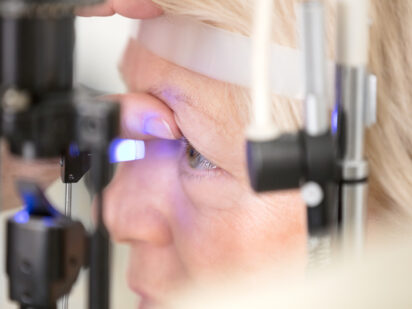For some patients their first symptom is trouble reading a newspaper. For others it’s a blind spot in the center of their vision. Age-related macular degeneration (AMD) is a progressive eye disease and a leading cause of vision loss among older adults.
AMD happens when the macula, located near the center of the retina, becomes damaged due one of two forms of AMD – wet or dry.
Dry macular degeneration occurs when parts of the macula develop tiny deposits of protein, causing a gradual loss of vision.
The wet form is less common but more severe. Wet AMD occurs when abnormal blood vessels grow under the retina and begin to leak blood or other fluids. This causes scarring of the macula, which can result in rapid vision loss.
Luckily, there’s an effective treatment for wet AMD. Injections of anti-vascular endothelial growth factor (anti-VEGF) have become a common treatment for wet AMD. These medications are injected directly into the eye to slow the formation of blood vessels and prevent further vision loss.
All ophthalmologists at Trinity Regional Eyecare provide these sight-saving injections for wet macular degeneration.
“We have provided this treatment since it was first discovered with amazing results,” said ophthalmologist Darrell Williams, MD. “Prior to this therapy, we lost vision in many eyes. This joins modern cataract surgery as another of the greatest miracles of modern medicine for protecting vision and preventing blindness.”
Who is at risk for wet AMD? You are more likely to develop this condition if you have a family history of AMD, are over 50 years of age or smoke cigarettes. Being overweight or having high blood pressure can be risk factors as well.
Sadly, many people aren’t aware they have AMD until their vision is quite blurry. This is why it’s important to have regular eye exams. For patients already diagnosed with AMD, the American Academy of Ophthalmology recommends daily monitoring of their vision using an Amsler grid, a square of graph paper with a black dot in the center. If any part of the grid looks increasingly blurry or out of shape, they need to contact their family ophthalmologist or optometrist.
When diagnosed and treated early enough, most patients can avoid severe loss of vision, and some patients will experience an improvement. The key is early diagnosis and treatment. For countless patients, this is the difference in being able to read, drive and continue lifestyle activities, which add greatly to quality of life.

